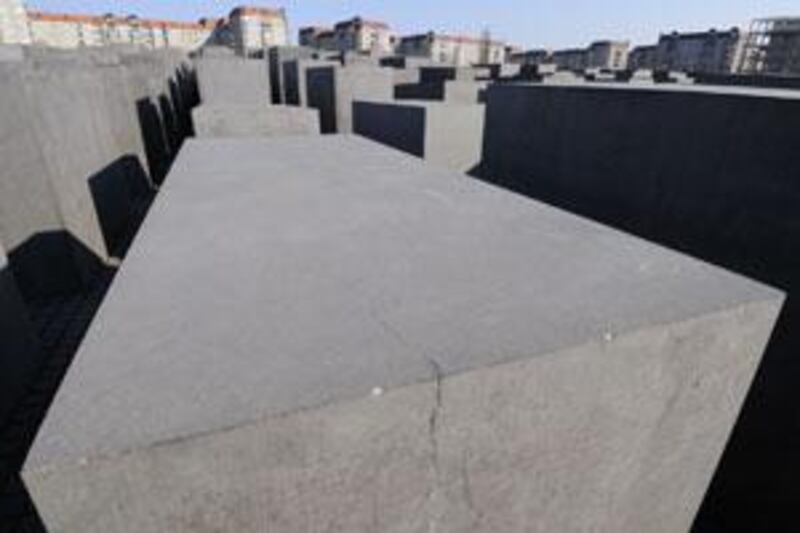BERLIN // The Holocaust memorial, a field of 2,700 grey-coloured concrete slabs erected in the German capital to commemorate the six million Jews killed in the Second World War, is crumbling just five years after it was opened.
Ugly cracks have appeared in 1,900 of the slabs, according to checks carried out before the winter, and the harsh frost since December is expected to have done further damage. Lime has seeped from the cracks in white trickles that commentators have likened to tears. "The whole monument seems to be grieving," wrote Süddeutsche Zeitung, one of Germany's leading newspapers. The foundation in charge of the memorial has not ruled out that it may seek damages from Peter Eisenman, the US architect who designed it. "An independent evidence-gathering process will establish who is responsible," said Leonie Mechelhoff, the spokeswoman for the foundation. She declined to confirm one newspaper report that a further 300 slabs were now affected.
"We won't know how many more slabs are damaged until we have made further checks, which will start in April after the frosty weather is over," Ms Mechelhoff said. "Then we'll decide how to solve the problem. We expect to repair the slabs rather than replace them." The damage threatens to overshadow a ceremony in May to mark the fifth anniversary of what is widely regarded as one of Germany's most important memorials.
It took 60 years for the country to erect it, and its design and location, just a short walk from the historic Brandenburg Gate, were deeply controversial. Construction experts say the type of fine concrete used and the lack of steel supports inside most of the slabs may be to blame for the damage. Frost worsens the cracks because it expands the water that has seeped into them. Another problem is the temperature differences the concrete undergoes on some days when it warms up rapidly in sunshine and then cools down in the shade.
Attempts to inject a form of resin into the cracks have failed to solve the problem. "It's an unacceptable situation," said the foundation's director, Uwe Neumärker. "No one knows if a slab will break apart one day." The slabs vary in height from a few centimetres to 4.7 metres. Seen from outside, they look like concrete waves. As one walks in among them, the ground slopes down, the slabs get taller and the sounds of traffic fade. The design is intended to create a sense of isolation and powerlessness, and to encourage people to think about the victims killed in extermination and concentration camps, in ghettos and in mass executions.
An underground information centre just 100m from the bunker now destroyed, where Hitler committed suicide, complements the memorial by portraying the fate of individual victims and explaining the industrial-scale killing. Before it was opened, the memorial was variously dismissed by critics as an "adventure playground", a "theme park of horror" and a disturbing attempt by Germany to draw a line under the Nazi past that has plagued it since 1945. There were fears that tourists would defile the site by sunbathing or munching cheeseburgers on the slabs, and that neo-Nazis would descend on it to spray swastikas on the concrete.
Martin Walser, a leading German intellectual and author, once referred to it as a "football pitch-sized nightmare, the monumentalisation of shame". Even Paul Spiegel, the leader of Germany's Jewish community at the time, complained that it only focused on the victims and made no reference to the people who committed the genocide. Others said it would distract attention from Germany's authentic memorial sites, the concentration camps Dachau, Buchenwald and Bergen-Belsen.
But the criticism has subsided and the fears that it would be abused by tourists and neo-Nazis have been proved wrong. Swastikas have been found daubed on some pillars, but that has happened far less often than expected. Security guards patrol the site and politely ask people who climb on the slabs to get down. Children run around and play hide-and-seek inside the memorial, but Mr Eisenman has always said that is not a problem. He intended it to be a living part of Berlin's landscape, open from all sides 365 days a year. Besides, school groups quickly fall silent when confronted with the tragic fates and staggering statistics of the genocide in the underground museum.
"Most people use the memorial very sensibly," Mr Neumärker said. "I don't know when we had the last graffiti. Every normal Berlin house facade is defaced more often." Many say the monument resembles a gigantic cemetery, which seems appropriate given that the majority of Jews murdered have no graves. Mr Eisenman argued successfully that attempts to commemorate the genocide with a conventional memorial would have been doomed to failure.
The monument, which cost ?27.6 million (Dh136.5m) and was funded by the government, is now one of Berlin's biggest tourist attractions. Well over eight million people have visited it since it opened, and some 2.3 million have been inside the museum. "There is no other country in the world that perpetrated industrial murder on this scale," said Lea Rosh, a journalist who initiated the campaign to build the memorial. "But there is no other nation in the world that has confronted its crimes so openly."
@Email:foreign.desk@thenational.ae






